Company Updates
Controversial Condiments: A Dip Dive into America’s Love / Hate Relationship with Saucy Spreads
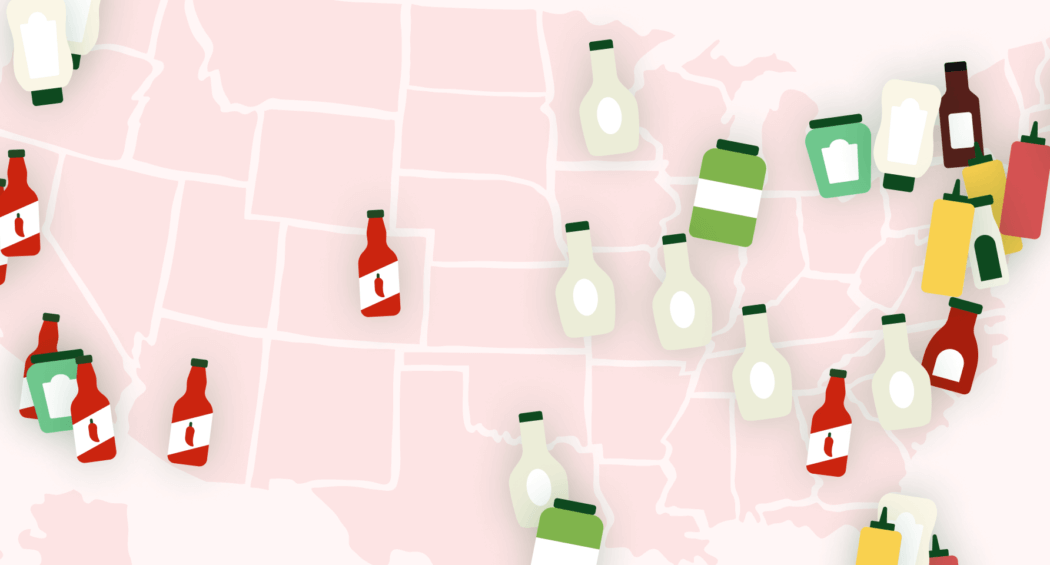
A BLT without mayo?
A Chicago hot dog without mustard?
Fries without ketchup?
No. Thank. You. All too often, these American classics get all the glory on their own, but it’s the condiments that really bring the flavors and textures to life and ultimately make or break a dish.
Relish in this: according to a recent Instacart survey of 2,013 Americans conducted online by The Harris Poll, 31% of Americans would never eat a dry sandwich.
However, when it comes to Americans and condiments…it’s complicated. To better understand the nitpicky needs and questionable quirks people have with condiments, we analyzed Instacart marketplace sales trends and The Harris Poll survey responses from more than 2,000 Americans nationwide*.
Let’s get saucy…These are the sauces, relishes, dressings, and spreads that Americans from the largest U.S. cities love to slather onto their sandwiches, dollop over their eggs, and squeeze onto their hot dogs.

America’s most hated condiments. With love comes hate. In the Instacart survey conducted online by The Harris Poll, we asked Americans which condiment they “hate with a passion,” and the results are spicy.
Despite hot sauce showing up as the most popular condiment across many U.S. cities according to purchase data (we delivered enough to fill nearly 14,000 kiddie pools over the past year), 24% of Americans in our survey indicated that they “hate hot sauce with a passion.” Here’s how the rest of the condiment aisle stacks up:
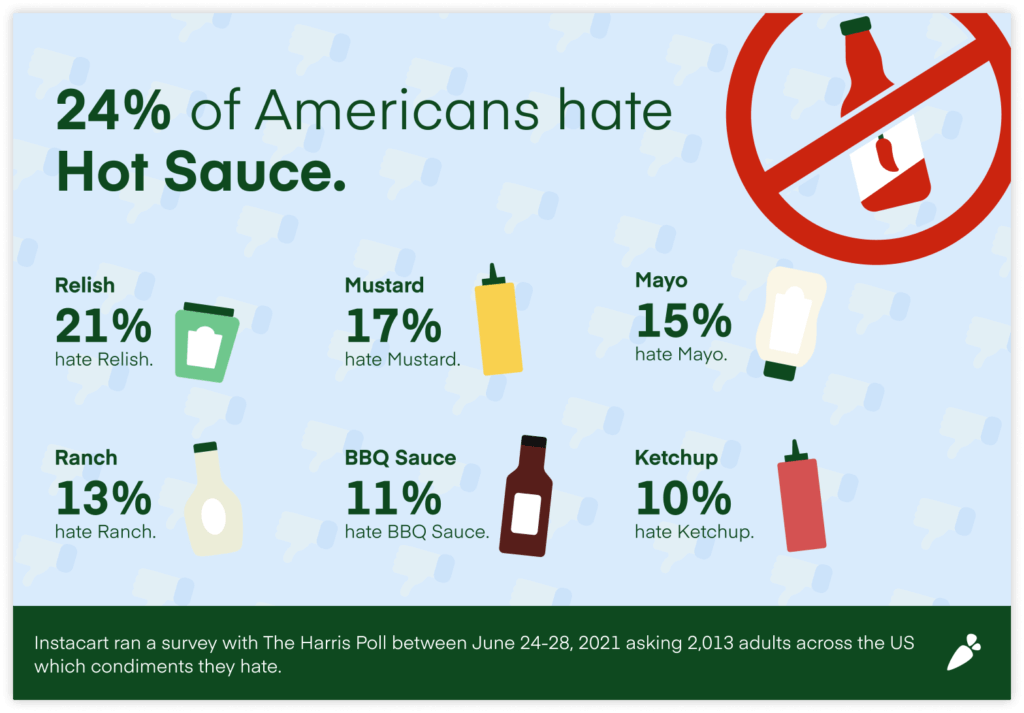
In addition, survey data reveals that hatred for certain condiments may be related to your age:
- Mustard: too cheugy for Gen Z. Mustard tops the list of condiments Gen-Zers (ages 18-24) say they hate with a passion (37%).
- Fickle for pickles. Relish tops the list of condiments Millennials (ages 25-40) say they hate with a passion (28%).
- With age comes…a mild palate. Hot sauce tops the list of condiments Gen-Xers (ages 41-56) and Boomers (ages 57-75) say they hate with a passion (24% each).
Don’t do *THIS* at the table. When it comes to breaking bread with others, many people are self-conscious about indulging in their unique condiment preferences. Among those Americans who sometimes put ketchup on their mac n’ cheese, nearly half (48%) say they would feel self-conscious doing so in front of other people.
While there’s no wrong way to enjoy a condiment, there are some ways that are more embarrassing than others. Here are some other condiment guilty pleasures with the percentage of people who indulge, saying they would feel self-conscious doing so in front of others:
- Dipping fries in mayonnaise: 34%
- Making fruit salad with mayonnaise: 30%
- Putting ketchup on eggs: 24%
- Putting ranch dressing on pizza: 23%
This or that: condiments edition. As we uncovered condiment preferences by region, we learned that certain condiments are extremely polarizing, with a strong preference for one condiment likely influencing others.
- BBQ vs hot sauce: which sauce is bauce?
Of all the condiments we looked at, hot sauce and BBQ sauce have the widest gap in consumer preference.
The southern and midwestern cities like St. Louis and Indianapolis much prefer to get their kick with tangy BBQ sauce, while cities on the west coast and in the southwest like San Francisco, Austin, and Los Angeles are more likely to grab hot sauce.
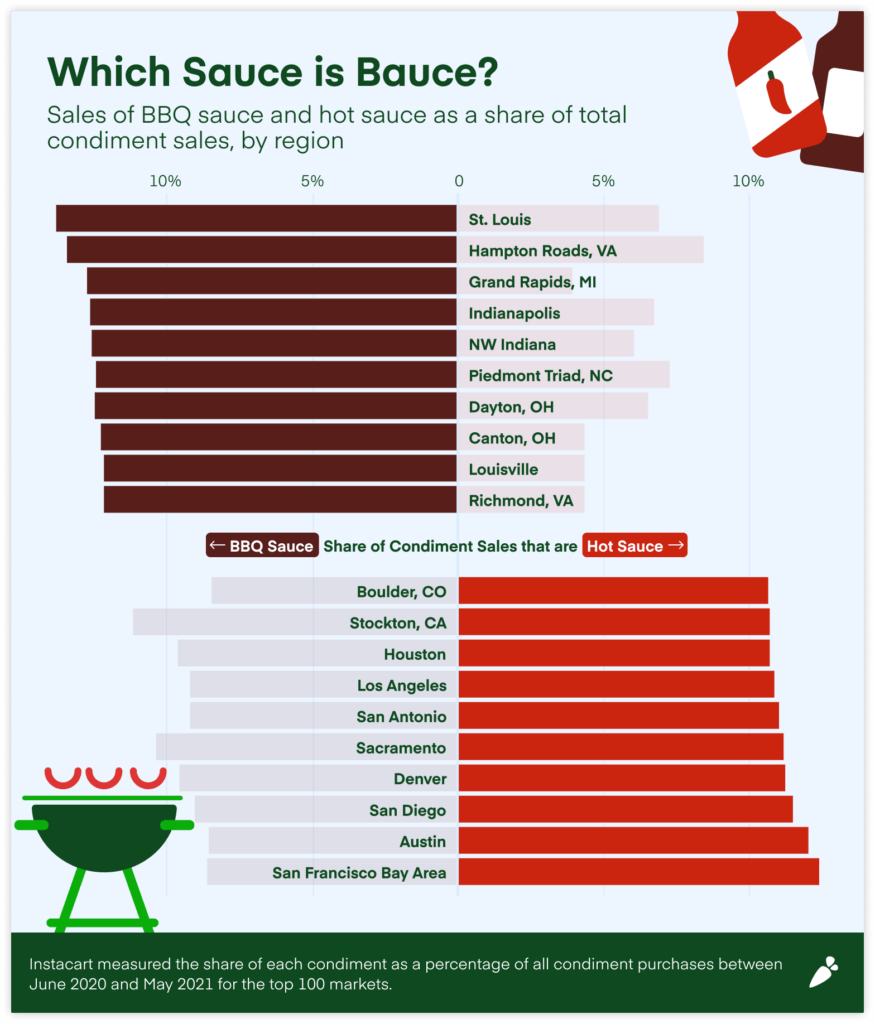
- Ketchup vs everything else.
And then there’s ketchup. When survey respondents were asked what single condiment they would use for the rest of their life if they had to choose, ketchup came out on top, garnering 23% of survey respondents.
“Sales via the Instacart marketplace reveal that consumers are extremely loyal to a select few ketchup products,” said Laurentia Romaniuk, Instacart’s Trends Expert. “One brand of ketchup, Heinz Classic Ketchup, dominates sales on Instacart and represents 52% of all ketchup sold via the platform. For a comparison, when we look at mustard, consumers seem to be a little more adventurous with their style and brands because no single mustard product has captured more than 16% of the share of the category.”
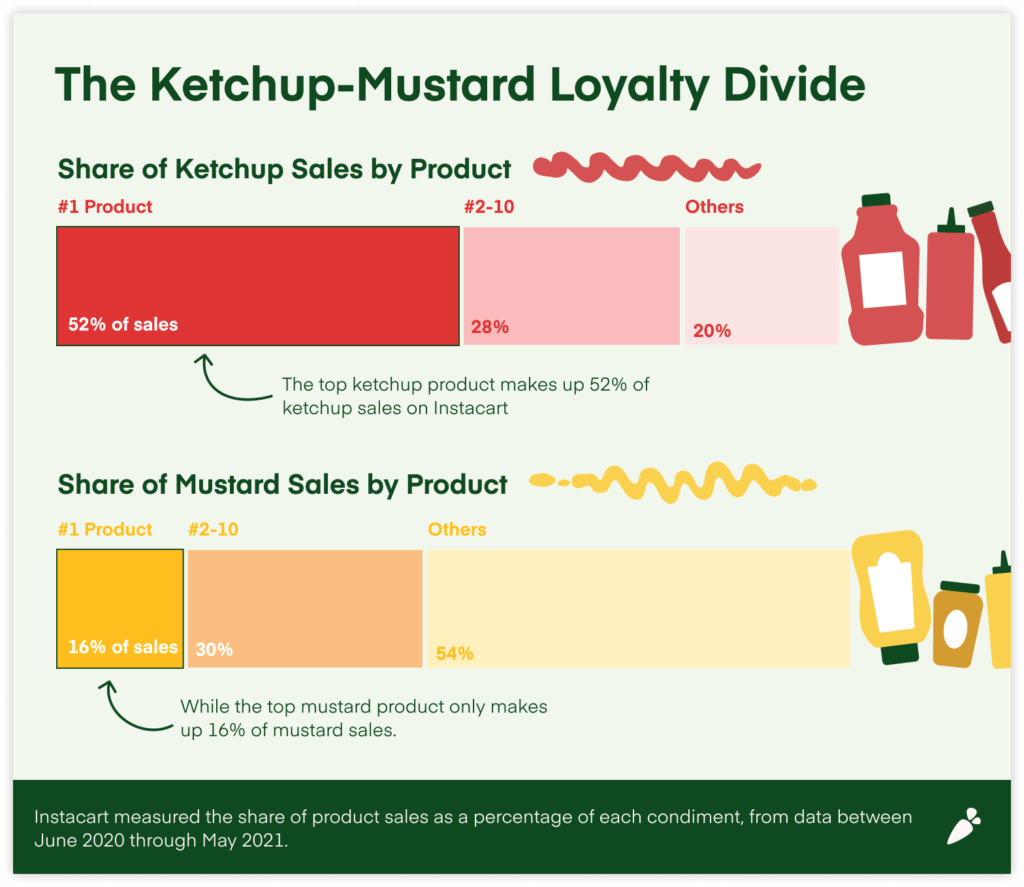
- A tale of two mustards: yellow & dijon.
When it comes to mustard, consumers have even more mixed emotions. Coastal cities and cities in the northeast like New York City, Boston, and San Francisco prefer fancy Dijon, while the rest of America prefers classic yellow mustard.
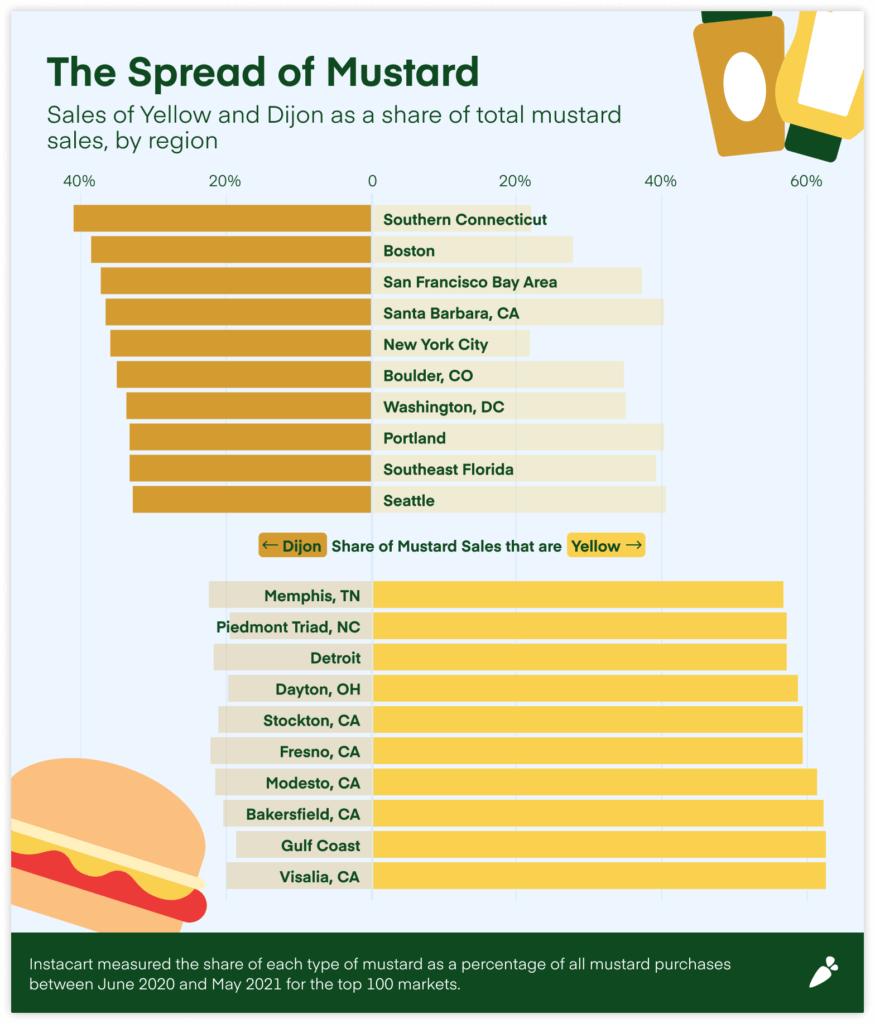
Happy dipping, America!
*Methodology
Instacart relied on a combination of Instacart marketplace sales data and consumer sentiment data from a survey commissioned by Instacart and conducted online by The Harris Poll to create this report.
Sales Data Analysis Method:
To understand regional differences in condiment sales, Instacart first looked at condiment sales from June 2020 – May 2021 across the entire platform. Instacart then compared the regional share of sales of each condiment to the national average.
Survey Method:
This survey was conducted online within the United States by The Harris Poll on behalf of Instacart from June 24-28, 2021 among 2,013 adults ages 18 and older. This online survey is not based on a probability sample and therefore no estimate of theoretical sampling error can be calculated. For complete survey methodology, including weighting variables and subgroup sample sizes, please contact [email protected].
Adjusting for Growth:
We adjust Instacart growth percentages by the overall growth of total deliveries. Doing so removes the influence of our platform growth so we can focus on the change in consumer behavior.
Most Recent in Company Updates

Company Updates
Tackling Food Deserts in Columbia, SC: First Year Success and Program Expansion Plans
Many people across the country continue to face challenges accessing food because they live in food deserts – areas where affordable food options, including fresh fruits and vegetables, are hard to find. But we have…
Feb 3, 2025
Company Updates
Instacart Celebrates Its First-Ever Big Game Ad with Free Snacks with Your Order, Deals & Surprise Deliveries
Fans can get in on the action with a week of game day deals, free snacks with your order, and even a chance to get their Big Game Instacart order delivered by beloved grocery brand…
Jan 30, 2025
Company Updates
Ordering Groceries With an AI Agent, Like OpenAI’s Operator
Instacart Continues to Drive the Future of AI, Leaning Into Agentic Tools If you’ve ever wished someone else would order your groceries–and you’re an OpenAI ChatGPT Pro subscriber–you’re in luck. With the introduction of AI-powered…
Jan 23, 2025

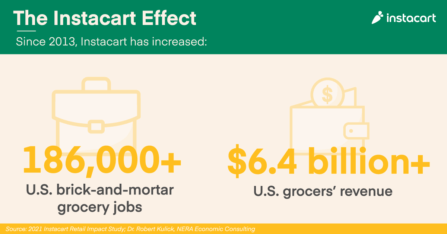 Instacart’s Impact on America’s Grocery Industry, by the Numbers
Instacart’s Impact on America’s Grocery Industry, by the Numbers 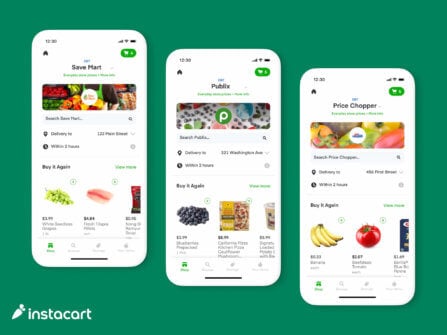 Breaking Down Barriers to Food Access with EBT SNAP Expansion
Breaking Down Barriers to Food Access with EBT SNAP Expansion  Beyond the Cart: A Year of Essential Stories
Beyond the Cart: A Year of Essential Stories 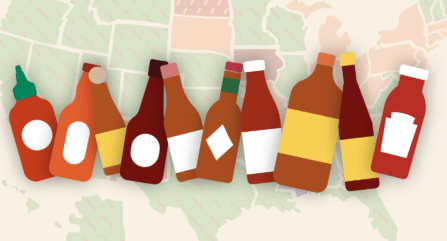 A Hot Take on America’s Favorite Hot Sauces 🌶
A Hot Take on America’s Favorite Hot Sauces 🌶  JuJu Smith-Schuster: What’s in my Cart?
JuJu Smith-Schuster: What’s in my Cart?  Introducing the First-Ever Instacart Emerging Brand List
Introducing the First-Ever Instacart Emerging Brand List 
